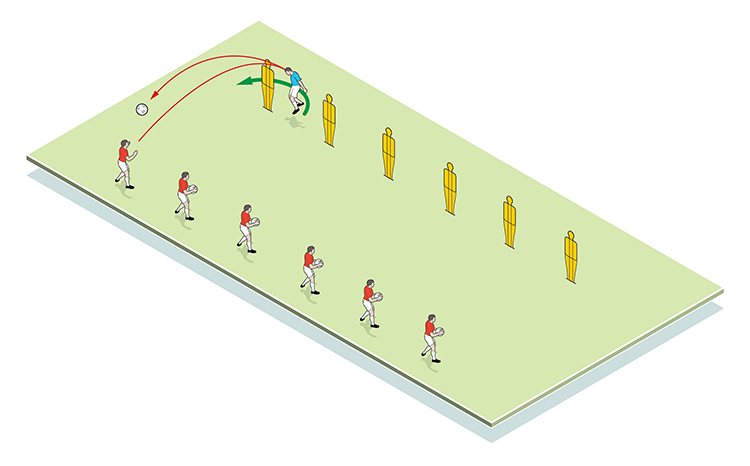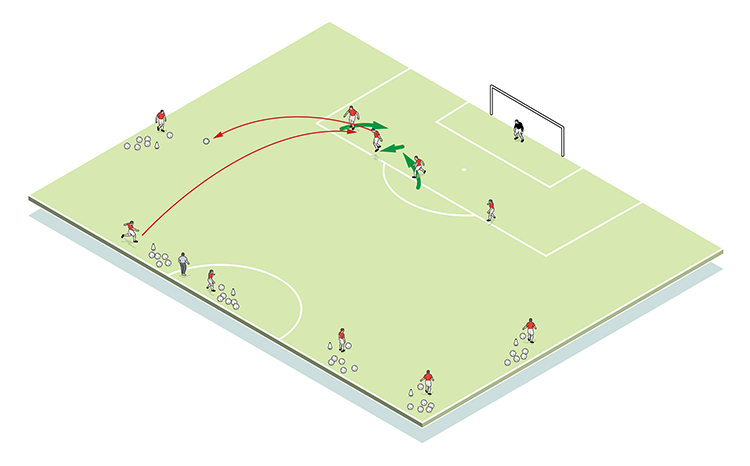You are viewing 1 of your 1 free articles
Defensive headers
This session examines the skill and art of defensive headers. It’s a simple exercise, but practice makes permanent.
| Area | Up to a half pitch |
| Equipment | Balls, cones, goals, mannequins |
| No. of Players | Up to 10 |
| Session Time | Each practice 15mins |
This session examines the skill and art of defensive headers. It’s a simple exercise, but practice makes permanent.
It’s my belief that this sort of session should be used weekly so that players get a firm steer on technique and body shape, yet accomplished heading remains a skill that is rarely practised in the modern game.
Every single game of football involves headers, and defensive headers at that, so this blueprint – which gets players working together, bonding and communicating – is of real value.
What do I get the players to do?
Heading arc
We begin in a small area, with seven defenders positioned in an arc (1). The practice requires players 2 to 7 to each have a ball in their hands. Player 1 moves forward five yards to player 2, touches the ball, then backpedals (2). Player 2 throws the ball up and over the player’s head, meaning he has to retreat quickly in order to head the ball back to player 2.
1

2

The practice continues, with player 1 making his way round to player 7, then back along the line to 2.
We rotate players so each takes a turn at being the header of the ball, then rerun, this time asking each player to see if they can head the ball over their server’s head. We can also adjust the distances between players, as required.
Double headers
For the next practice, we’re looking for two headers from each server throw – the distance is now 10 yards between players. This set-up requires mannequins, although if you don’t have any, you can use cones or even static players. The heading player starts on the inside shoulder of the mannequin for the first header, then moves round to the outside shoulder for the second header (3a). He continues along the line until reaching the end (3b); we then rotate players.
3a

3b

What are the key things to look out for?
Body shape is vital in this practice, with shoulders across the pitch – if they’re not, the headers will go off at different angles.
The working player must have a spring in his jump, with eyes open and good timing to meet the ball. And the use of neck muscles in heading the ball back with power and control, is crucial.
How do I progress the session?
We can set up a back four with servers playing balls in from all areas of the pitch. Balls should be headed back to where they came from, with height, distance and power (4).
4

Related Files
Editor's Picks
Intensive boxes drill with goals
Penetrating the final third
Creating and finishing
My philosophy
Pressing initiation
Compact team movement
Defensive organisation
Back three tactics
Counter-pressing as an offensive weapon
Coaches' Testimonials

Alan Pardew

Arsène Wenger

Brendan Rodgers

Carlos Carvalhal

José Mourinho

Jürgen Klopp

Pep Guardiola

Roy Hodgson

Sir Alex Ferguson

Steven Gerrard
Related
Sunflower positioning
Passing and running in behind
Counter-attacking on transitions
Coaches' Testimonials

Gerald Kearney, Downtown Las Vegas Soccer Club

Paul Butler, Florida, USA

Rick Shields, Springboro, USA

Tony Green, Pierrefonds Titans, Quebec, Canada
Join the world's leading coaches and managers and discover for yourself one of the best kept secrets in coaching. No other training tool on the planet is written or read by the calibre of names you’ll find in Elite Soccer.
In a recent survey 92% of subscribers said Elite Soccer makes them more confident, 89% said it makes them a more effective coach and 91% said it makes them more inspired.
Get Monthly Inspiration
All the latest techniques and approaches
Since 2010 Elite Soccer has given subscribers exclusive insight into the training ground practices of the world’s best coaches. Published in partnership with the League Managers Association we have unparalleled access to the leading lights in the English leagues, as well as a host of international managers.
Elite Soccer exclusively features sessions written by the coaches themselves. There are no observed sessions and no sessions “in the style of”, just first-hand advice delivered direct to you from the coach.








